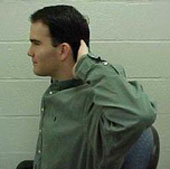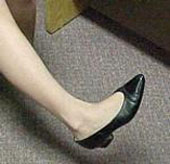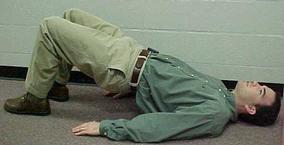Because of a lapse in government funding, the information on this website may not be up to date, transactions submitted via the
website may not be processed, and the agency may not be able to respond to inquiries until appropriations are enacted. The NIH
Clinical Center (the research hospital of NIH) is open. For more details about its operating status, please visit
cc.nih.gov.
Updates regarding government operating status and resumption of normal operations can be found at
opm.gov.
Health and Wellness
Exercises and Stretches
Page Content
Ergonomics is simply “fitting the task to the worker” rather than forcing the worker to fit the task. Applying ergonomic principles to work stations can help prevent a variety of conditions, such as back pain and carpal tunnel syndrome. Small adjustments to the position of a chair, keyboard, or monitor can lead to big improvements in employee comfort and productivity.
* Exercises are recommended for healthy adults and should not lead to any pain or discomfort. Please consult with your physician or the Office of Research Services, Division of Occupational Health and Safety (DOHS) for further information.
Select one of the links below to scroll down for more information:
Eye Exercises
Eye Comfort Exercises
- Blinking (produces tears to help moisten and lubricate the eyes).
- Yawning (produces tears to help moisten and lubricate the eyes).
- Expose eyes to natural light.
Eye Movements
- Close eyes.
- Slowly and gently move eyes up to the ceiling, then slowly down to the floor.
- Repeat 3 times.
- Close eyes.
- Slowly and gently move eyes to the left, then slowly to the right.
- Repeat 3 times.
Focus Change
- Hold one finger a few inches away form the eye.
- Focus on the finger.
- Slowly move the finger away.
- Focus far into the distance and then back to the finger.
- Slowly bring the finger back to within a few inches of the eye.
- Focus on something more than 8 feet away.
- Repeat 3 times.
back to the top
Musculoskeletal Exercises
Deep Breathing
- While standing, or in an otherwise relaxed position.
- Place one hand on the abdomen and one on the chest.
- Inhale slowly through the nose.
- Hold for 4 seconds.
- Exhale slowly through the mouth.
- Repeat.
Cable Stretch
- While sitting with chin in, stomach in, shoulders relaxed, hands relaxed in lap, and feet flat on the floor, imagine a cable pulling your head upward.
- Hold for 3 seconds and relax.
- Repeat 3 times.
Side Bend: Neck Stretch
-
 Tilt head to one side (ear towards shoulder).
Tilt head to one side (ear towards shoulder). - Hold for 15 seconds.
- Relax.
- Repeat 3 times on each side.
Diagonal Neck Stretch
-
 Turn head slightly and then look down as if looking in your pocket.
Turn head slightly and then look down as if looking in your pocket. - Hold for 15 seconds.
- Relax.
- Repeat 3 times on each side.
Shoulder Shrug
- Slowly bring shoulders up to the ears and hold for approximately 3 seconds.
- Rotate shoulders back and down.
- Repeat 10 times.
Executive Stretch
-
 While sitting, lock hands behind head.
While sitting, lock hands behind head. - Bring elbows back as far as possible.
- Inhale deeply while leaning back and stretching.
- Hold for 20 seconds.
- Exhale and relax.
- Repeat 1 time.
Foot Rotation
-
 While sitting, slowly rotate each foot from the ankle.
While sitting, slowly rotate each foot from the ankle. - Rotate 3 times in one direction, then 3 times in the opposite direction.
- Relax.
- Repeat 1 time.
Hand Shake
- While sitting, drop arms to the side.
- Shake hands downward gently.
- Repeat frequently.
Hand Massage (Note: Perform very gently!)
- Massage the inside and outside of the hand using the thumb and fingers.
- Repeat frequently (including before beginning work).
Finger Massage (Note: Perform very gently!)
- Massage fingers of each hand individually, slowly, and gently.
- Move toward nail gently.
- Massage space between fingers.
- Perform daily.
Wrist Stretch
- Hold arm straight out in front of you.
- Pull the hand backwards with the other hand, then pull downward.
- Hold for 20 seconds.
- Relax.
- Repeat 3 times each.
Just as an athlete prepares before playing a sport, you too should prepare before work to help prevent back injuries. These slow stretches help prevent back injuries and make your muscles more flexible. Hold each position for 20 seconds and repeat 3 times before work.
Back Exercises
It doesn't take much time to improve the strength and flexibility of your back. In just 10 minutes a day, you can perform a few exercises, which can prevent a lifetime of low back pain!
Partial Sit-up
This exercise strengthens your stomach muscles:

- Lie on your back with both knees bent and your feet flat on the floor. Slowly raise your head and shoulders off the floor, keeping your hands across your chest.
- Work up to 30 repetitions.
Bridge
This exercise strengthens your low back:
- Lie on your back with both knees
 bent and your feet flat on the floor.
bent and your feet flat on the floor. - With arms lying at your sides, tighten stomach muscles, squeeze buttocks, and slowly raise your hips into the air. Hold for 5 seconds and then slowly bring the buttocks back to the floor.
- Repeat 20 times.
Wall Slide

This exercise strengthens your back and leg muscles:
back to the top
Aerobic exercise stretches and strengthens the muscles that support your low back, which combined with healthy eating can also help you maintain your ideal weight. If you're overweight, the extra pounds add to the strain on your lower back. Aerobic exercise like walking, can help you lose weight.
Proper Rest
The best position for resting the back muscles is lying on your back on your living room floor with a pillow under your knees and a rolled up towel under your neck. You can also lie on your side in the fetal position—bend the knees to reduce strain on the lower back and put a pillow between your knees, and under your head and neck to keep them level.
